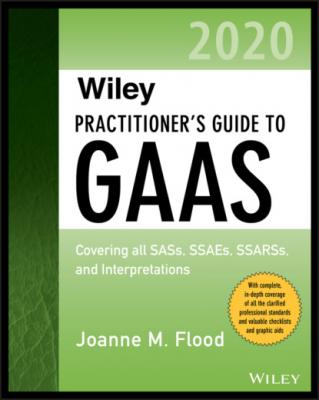Wiley Practitioner's Guide to GAAS 2020. Joanne M. Flood
Читать онлайн.| Название | Wiley Practitioner's Guide to GAAS 2020 |
|---|---|
| Автор произведения | Joanne M. Flood |
| Жанр | Бухучет, налогообложение, аудит |
| Серия | |
| Издательство | Бухучет, налогообложение, аудит |
| Год выпуска | 0 |
| isbn | 9781119596035 |
Standardization of Audit Documentation
Preparation of Audit Documentation
Quality of Audit Documentation
Audit Documentation Deficiencies
Documentation Requirements in Other Sections
Providing Access to or Copies of Audit Documentation to a Regulator
SCOPE
AU-C 230 concerns the audit documentation the auditor is expected to prepare. See also other standards, laws, or regulations. (AU-C 230.01)
DEFINITIONS OF TERMS
Source: AU-C 230.06. For definitions related to this standard, see Appendix A, “Definitions of Terms”: Audit documentation, Audit file, Documentation completion date, Experienced auditor, Report release date.
OBJECTIVE OF AU-C SECTION 230
AU-C Section 230.05 states that:
The objective of the auditor is to prepare documentation that provides
1 a sufficient and appropriate record of the basis for the auditor’s report; and
2 evidence that the audit was planned and performed in accordance with GAAS and applicable legal and regulatory requirements.
(AU-C Section 230.05)
REQUIREMENTS
Requirement for Audit Documentation
The auditor must prepare audit documentation, on a timely basis, in sufficient detail to provide evidence:
About the conclusions reached; and
That the audit was planned and performed in accordance with GAAS and relevant legal and regulatory requirements.
(AU-C 230.02)
The form and content of the audit documentation should be designed for the specific engagement.
Audit documentation also:
Helps the team plan the audit
Provides information for supervisors to direct the audit
Provides documentation for review
Supplies backup that the team performed as required by standards
Provides files to be used on future audits
Provides documentation for internal review and inspections and external reviews
Provides documentation for successor auditors
Helps auditors understand prior year words
Form, Content, and Extent of Audit Documentation
The quantity, type, and content of the audit documentation are based on the auditor’s professional judgment and vary with the engagement. Factors to consider in determining the content of audit documentation are discussed in the following paragraphs.
The Audience
The auditor should prepare audit documentation on a timely basis that would allow an experienced auditor1 having no previous connection with the audit to understand:
The nature, timing, and extent of auditing procedures performed to comply with GAAS and applicable legal and regulatory requirements;
The results of the audit procedures performed and the audit evidence obtained; and
The significant findings for issues that arose during the audit, the conclusions reached on those significant matters, and professional judgments made in reaching those conclusions.
(AU-C 230.08)
Sufficiency of Audit Documentation
Audit documentation should include:
Who reviewed specific audit work and the date and extent of the review
Who performed the audit work and the date the work was completed
Identifying characteristics of specific items tested
(AU-C 230.09)
Audit documentation should also include abstracts or copies of significant contracts or agreements that involved audit procedure. (AU-C 230.10)
Documentation of Significant Findings
The auditor should document significant audit findings or issues, actions taken to address them (including additional evidence obtained), and the basis of the conclusions reached. (AU-C 230.11) Significant audit findings or issues include:
Matters that are both significant and involve the appropriate selection, application, and consistency of accounting principles with regard to the financial statements, including related disclosures. Such matters often relate to (1) accounting for complex or unusual transactions or (2) estimates and uncertainties, and the related management assumptions, if applicable.Results of auditing procedures that indicate that the financial statements or disclosures could be materially misstated or that the auditing procedures need to be significantly modified.Circumstances that cause significant difficulty in applying necessary auditing procedures.Other findings that could result in a modified auditor’s report.(AU-C 230.A10)
The auditor should document discussions with management and those charged with governance, including when and with whom, about significant findings. (AU-C 230.11)
Departures from a Relevant Requirement
The auditor may find it necessary to not perform a required procedure. If so, the auditor should document the reason for the departure and how alternative procedures enabled the auditor to fulfill the objectives of the audit. (AU-C 230.13)
This documentation is required only if the required procedure is relevant to the audit. For example, if the entity does not have an internal audit function, procedures in AU-C 610 would not be relevant.
Factors to Consider in Determining the Nature and Extent of Audit Documentation
The auditor should consider the following factors in determining the
